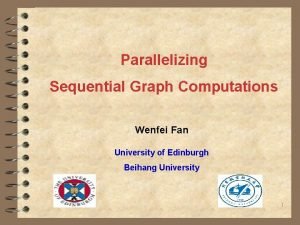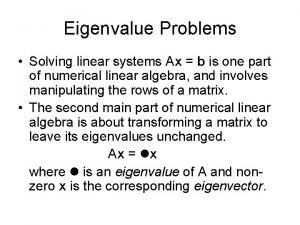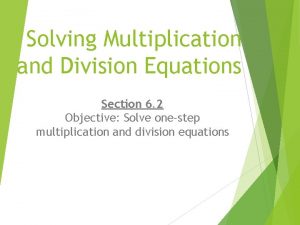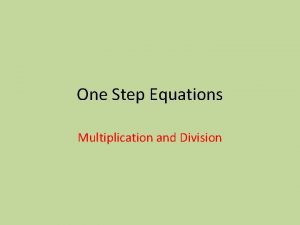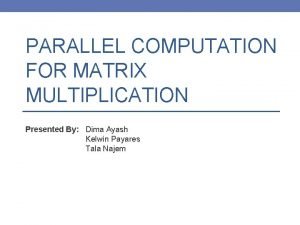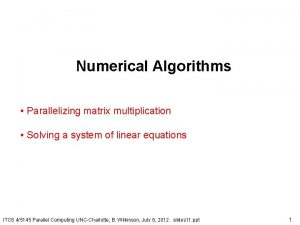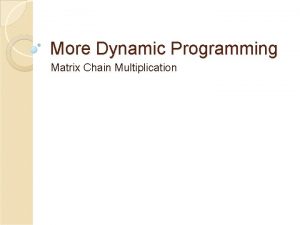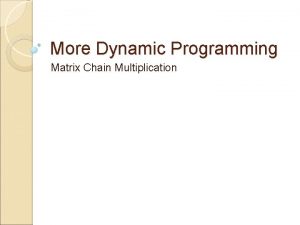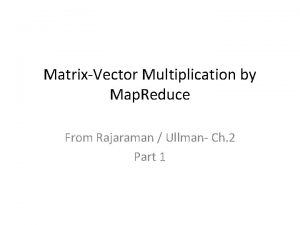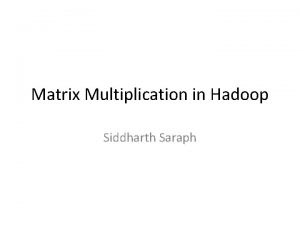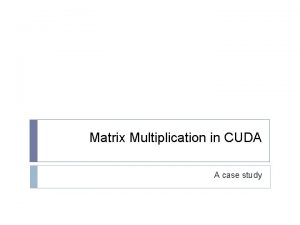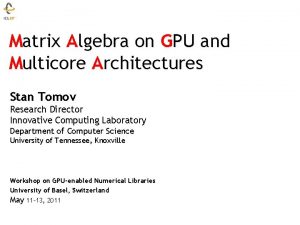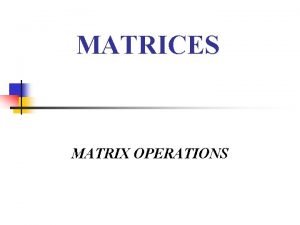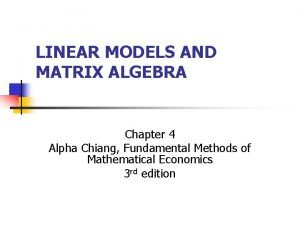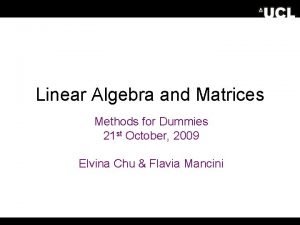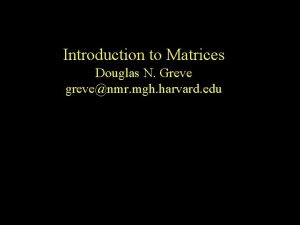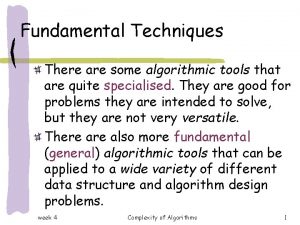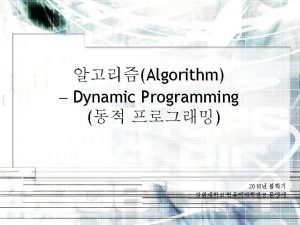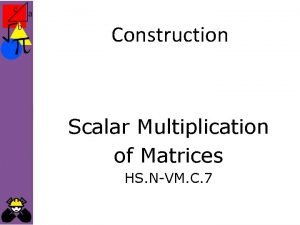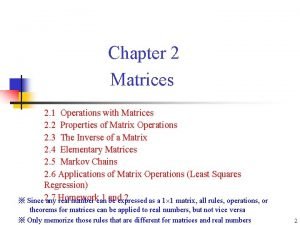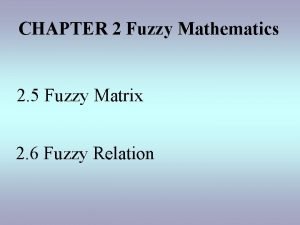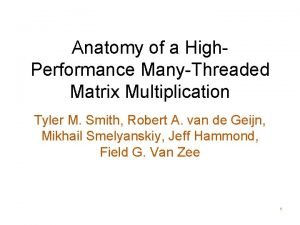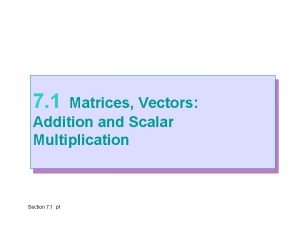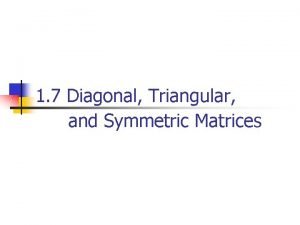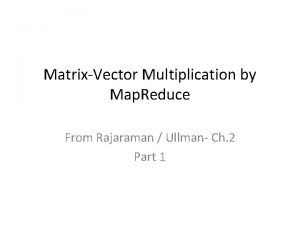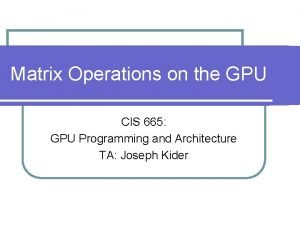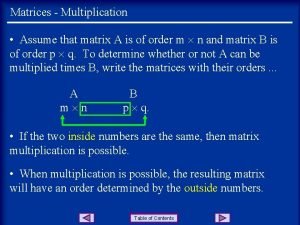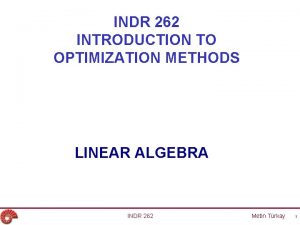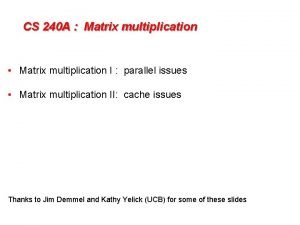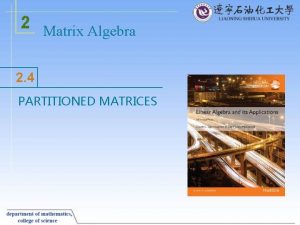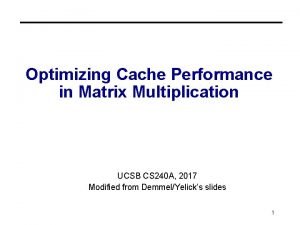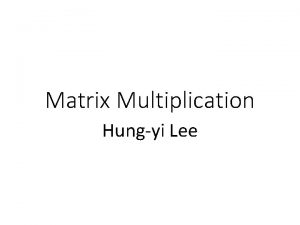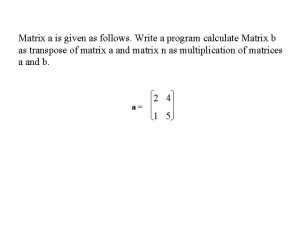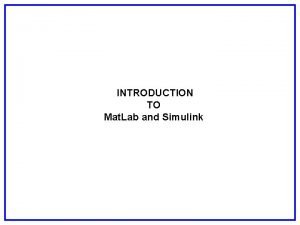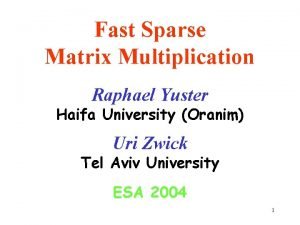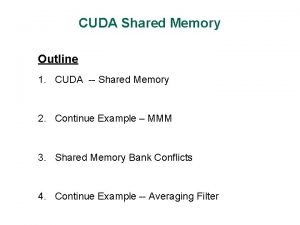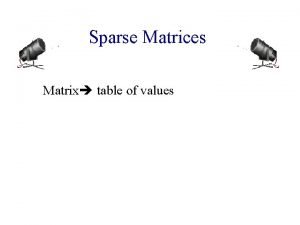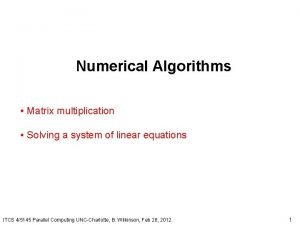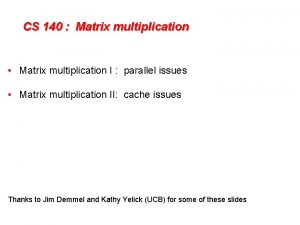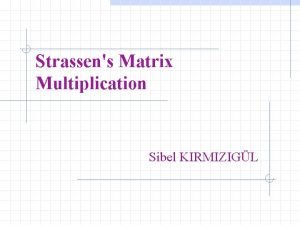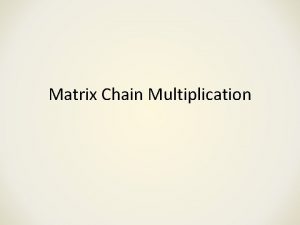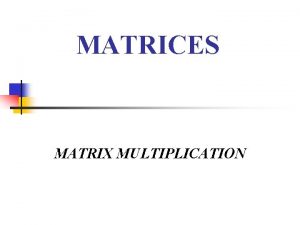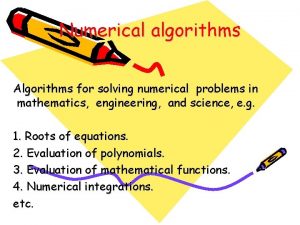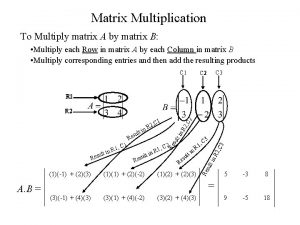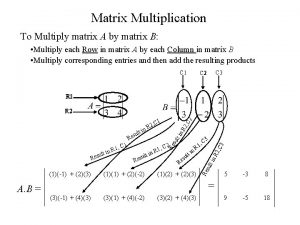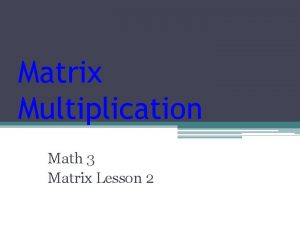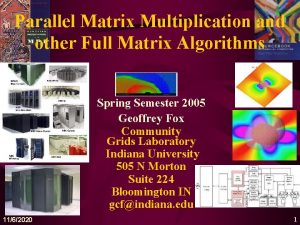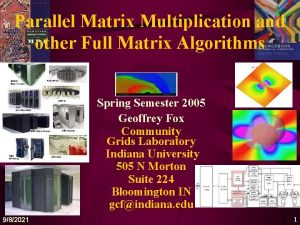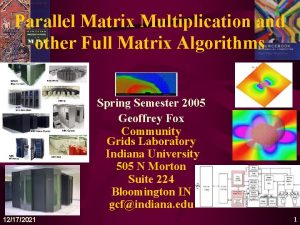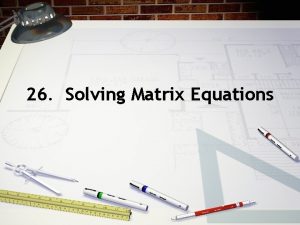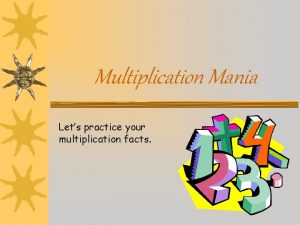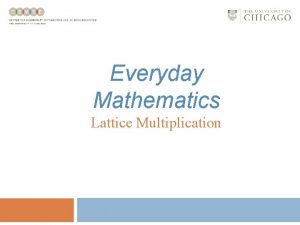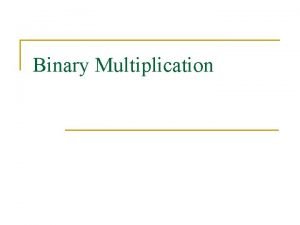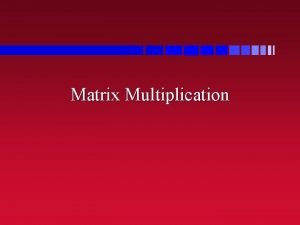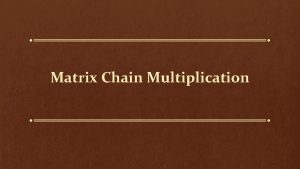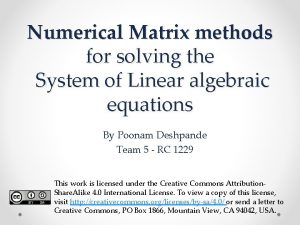Numerical Algorithms Parallelizing matrix multiplication Solving a system












































- Slides: 44

Numerical Algorithms • Parallelizing matrix multiplication • Solving a system of linear equations ITCS 4/5145 Parallel Computing UNC-Charlotte, B. Wilkinson, July 8, 2012. slides 11. ppt 1

Matrices — A Review An n x m matrix 2

Matrix Addition, C = A + B Add corresponding elements of each matrix to form elements of result matrix. Given elements of A as ai, j and elements of B as bi, j, each element of C computed as: Add A B C Easy to parallelize – each processor computes one C element or group of C elements 3

Matrix Multiplication, C = A * B Multiplication of two matrices, A and B, produces matrix C whose elements, ci, j (0 <= i < n, 0 <= j < m), computed as follows: where A is an n x l matrix and B is an l x m matrix. 4

Matrix-Vector Multiplication c=Axb A is a matrix, b and c are vectors. Matrix-vector multiplication follows directly from definition of matrix-matrix multiplication by making B an n x 1 matrix (vector). Result an n x 1 matrix (vector). 5

Relationship of Matrices to Linear Equations A system of linear equations can be written in matrix form: Ax = b Matrix A holds the a constants x is a vector of the unknowns b is a vector of the b constants. 6

Parallelizing Matrix Multiplication Assume throughout that matrices square (n x n matrices). Sequential code to compute A x B could simply be for (i = 0; i < n; i++) // for each row of A for (j = 0; j < n; j++) { // for each column of B c[i][j] = 0; for (k = 0; k < n; k++) c[i][j] = c[i][j] + a[i][k] * b[k][j]; } Requires n 3 multiplications and n 3 additions Sequential time complexity of O(n 3). Very easy to parallelize by changing one or both for loops to forall as each result element independent of other result 7

Parallel Code With p processors (and n x n matrices with n = p), can obtain: • Time complexity of O(n 2) with n processors Each instance of outer (or inner) loop independent and can be done by a separate processor. Cost optimal since n x O(n 2) = O(n 3) • Time complexity of O(n) with n 2 processors Each instance of inner and outer loop independent and can be done by a separate processor. One element of C computed by one procesor. Cost optimal since n 2 x O(n) = O(n 3) • Time complexity of O(log n) with n 3 processors By parallelizing the inner loop, see next. Not cost-optimal. O(log n) lower bound for parallel matrix multiplication. Cost-optimal: when time complexity x no of processors same as sequential time complexity 8

Using n 3 processors Tree construction: n numbers can be added in log n steps using n processors: Computational time complexity of O(log n) using n 3 processors. 9

Usually size of matrices (n) much larger than number of processors (p). So divide matrix into s 2 submatrices. Each submatrix has n/s x n/s elements. One processor produces each submatrix result (p = s 2). Block Matrix Multiplication Can be applied to all parallelization methods. for (p = 0; p < s; p++) for (q = 0; q < s; q++) { Cp, q = 0; /* clear elements of submatrix*/ for (r = 0; r < m; r++) /* submatrix multiplication */ Cp, q = Cp, q + Ap, r * Br, q; /*add to accum. submatrix*/ } Means multiply submatrix Ap, r and Br, q using matrix multiplication and add to submatrix Cp, q using matrix addition. 10

Recursive implementation of matrix multiplication Apply same algorithm on each submatrix recursively. Excellent algorithm for a shared memory systems because of locality of operations. 11

Recursive Algorithm mat_mult(A, B, s) { if (s == 1) C = A * B; else { s = s/2; P 0 = mat_mult(App, Bpp, s); P 1 = mat_mult(Apq, Bqp, s); P 2 = mat_mult(App, Bpq, s); P 3 = mat_mult(Apq, Bqq, s); P 4 = mat_mult(Aqp, Bpp, s); P 5 = mat_mult(Aqq, Bqp, s); P 6 = mat_mult(Aqp, Bpq, s); P 7 = mat_mult(Aqq, Bqq, s); Cpp = P 0 + P 1; Cpq = P 2 + P 3; Cqp = P 4 + P 5; Cqq = P 6 + P 7; } return (C); } /* if submatrix has one element */ /* multiply elements */ /* else continue to make recursive calls */ /* the number of elements in each row/column*/ /* add submatrix products */ /* to form submatrices of final matrix */ /* return final matrix */ 12

Mesh algorithms Processors organized in a 2 -D mesh: Algorithms: • Cannon’s algorithm • Fox’s algorithm (not in textbook but similar complexity) • Systolic array All involve shifting elements of arrays through mesh. Assumes message passing between processors (left/right/up/down). Accumulate partial sums at each processor. 13

Cannon’s Algorithm Step 1: Initial placement of elements 1. Initially processor Pi, j has elements ai, j and bi, j 14

Step 2 — Alignment of elements of A and B Elements moved from their initial position to an “aligned” position. ith row of A shifted i places left and jth column of B shifted j places upward. Has effect of placing element ai, j+i and element bi+j, j in processor Pi, j. These elements are a pair of those required in accumulation of ci, j. 15

Step 3 — Multiply elements Each processor, Pi, j, multiplies its elements and adds result to accumulating sum (initially sum = 0). 16

Step 4 - One-place shift of elements of A and B ith row of A shifted one place left, and jth column of B shifted one place upward. Has effect of bringing together adjacent elements of A and B, which will also be required in accumulation. Steps 3 and 4 repeated until final result obtained (n - 1 shifts with n rows and n columns of elements). 17

18

19

Solving a System of Linear Equations Objective is to find values for the unknowns, x 0, x 1, …, xn-1, given values for a 0, 0, a 0, 1, …, an-1, and b 0, …, bn. 20

Solving System of Linear Equations Dense matrices Gaussian Elimination - parallel time complexity O(n 2) Sparse matrices By iteration - depends upon iteration method and number of iterations but typically O(log n) • Jacobi iteration • Gauss-Seidel relaxation (not good for parallelization) • Red-Black ordering • Multigrid 21

Gaussian Elimination Convert general system of linear equations into triangular system of equations. Then solve by Back Substitution. Uses characteristic of linear equations that any row can be replaced by that row added to another row multiplied by a constant. Starts at first row and works toward bottom row. At ith row, each row j below ith row replaced by row j + (row i) (-aj, i/ ai, i). Constant used for row j is -aj, i/ai, i. Has effect of making all elements in ith column below ith row zero because: 22

Gaussian elimination 23

Partial Pivoting If ai, i is zero or close to zero, will not be able to compute quantity -aj, i/ai, i. Procedure must be modified into so-called partial pivoting by swapping ith row with row below it that has largest absolute element in ith column of any of rows below ith row if there is one. (Reordering equations will not affect the system. ) In the following, we will not consider partial pivoting. 24

Sequential Code Without partial pivoting: for (i = 0; i < n-1; i++) /* for each row, except last */ for (j = i+1; j < n; j++) { /*step thro subsequent rows */ m = a[j][i]/a[i][i]; /* Compute multiplier */ for (k = i; k < n; k++) /*last n-i-1 elements of row j*/ a[j][k] = a[j][k] - a[i][k] * m; b[j] = b[j] - b[i] * m; /* modify right side */ } The time complexity is O(n 3). 25

Parallel Implementation Efficiency relatively low because all processors before processor holding row i do not participate in computation again. Communication and computational time complexity is O(n 2) 26 (see textbook)

Less processor than rows Strip Partitioning Poor processor allocation! Processors do not participate in computation after their last row is processed. 27

Cyclic-Striped Partitioning An alternative which equalizes the processor workload: 28

Iterative Methods Time complexity of direct method at O(n 2) with n processors, is significant. Time complexity of iteration method depends upon: • type of iteration, • number of iterations • number of unknowns, and • required accuracy but can be less than direct method especially for a few unknowns i. e. a sparse system of linear equations. 29

Jacobi Iteration formula: ith equation rearranged to have ith unknown on left side: 30

Example of a Sparse System of Linear Equations Laplace’s Equation Solve for f over the two-dimensional x-y space. For computer solution, finite difference methods appropriate Two-dimensional solution space “discretized” into large number of solution points. 31

Finite Difference Method 32

33

Natural Order 34

Relationship with a General System of Linear Equations Using natural ordering, ith point computed from ith equation: which is a linear equation with five unknowns (except those with boundary points). In general form, the ith equation becomes: 35

36

Gauss-Seidel Relaxation Uses some newly computed values to compute other values in that iteration. 37

Gauss-Seidel Iteration Formula where superscript indicates iteration. With natural ordering of unknowns, formula reduces to At kth iteration, two of the four values (before ith element) taken from kth iteration and two values (after ith element) taken from (k-1)th iteration. Have: 38

Red-Black Ordering First, black points computed. Next, red points computed. Black points computed simultaneously, and red points computed simultaneously. 39

Red-Black Parallel Code forall (i = 1; i < n; i++) forall (j = 1; j < n; j++) if ((i + j) % 2 == 0) /* compute red points */ f[i][j] = 0. 25*(f[i-1][j] + f[i][j-1] + f[i+1][j] + f[i][j+1]); forall (i = 1; i < n; i++) forall (j = 1; j < n; j++) if ((i + j) % 2 != 0) /* compute black points */ f[i][j] = 0. 25*(f[i-1][j] + f[i][j-1] + f[i+1][j] + f[i][j+1]); 40

Multigrid Method First, a coarse grid of points used. With these points, iteration process will start to converge quickly. At some stage, number of points increased to include points of coarse grid and extra points between points of coarse grid. Initial values of extra points found by interpolation. Computation continues with this finer grid. Grid can be made finer and finer as computation proceeds, or computation can alternate between fine and coarse grids. Coarser grids take into account distant effects more quickly and provide a good starting point for the next finer grid. 41

Multigrid processor allocation 42

(Semi) Asynchronous Iteration As noted early, synchronizing on every iteration will cause significant overhead - best if one can is to synchronize after a number of iterations. Need to establish that will converge. 43

Questions 44
 When graphs are life
When graphs are life Eigen value problem
Eigen value problem Solving multiplication equations
Solving multiplication equations One step equations multiplication and division
One step equations multiplication and division 3-3 solving inequalities by multiplication or division
3-3 solving inequalities by multiplication or division Solving inequalities by multiplying or dividing
Solving inequalities by multiplying or dividing Solving multiplication and division equations
Solving multiplication and division equations Solving inequalities using multiplication or division
Solving inequalities using multiplication or division Fox algorithm matrix multiplication
Fox algorithm matrix multiplication Matrix multiplication time complexity
Matrix multiplication time complexity Matrix chain multiplication definition
Matrix chain multiplication definition Dynamic programming matrix multiplication
Dynamic programming matrix multiplication Matrix vector multiplication by mapreduce
Matrix vector multiplication by mapreduce Hadoop matrix multiplication
Hadoop matrix multiplication Cuda matrix multiplication
Cuda matrix multiplication Gpu stan
Gpu stan 3x2 matrix
3x2 matrix Matrix multiplication linear algebra
Matrix multiplication linear algebra Matrix mxn
Matrix mxn 2 by 2 matrix inverse example
2 by 2 matrix inverse example How to multiply matrices 3x3
How to multiply matrices 3x3 Matrix multiplication time complexity
Matrix multiplication time complexity Matrix chain multiplication 알고리즘
Matrix chain multiplication 알고리즘 Matrix inverse
Matrix inverse Scalar multiplication matrix
Scalar multiplication matrix Site:slidetodoc.com
Site:slidetodoc.com Fuzzy matrix definition
Fuzzy matrix definition Anatomy of high-performance matrix multiplication
Anatomy of high-performance matrix multiplication Matrix multiplication associative property
Matrix multiplication associative property Scalar multiplication matrix
Scalar multiplication matrix Multiplication of diagonal matrix
Multiplication of diagonal matrix Matrix vector multiplication mapreduce
Matrix vector multiplication mapreduce Cuda matrix multiplication optimization
Cuda matrix multiplication optimization Matrix multiplication table
Matrix multiplication table Indr 262
Indr 262 Matrix
Matrix Partitioned matrices
Partitioned matrices Matrix multiplication cache optimization
Matrix multiplication cache optimization Vivado hls matrix multiplication example
Vivado hls matrix multiplication example Matrix multiplication
Matrix multiplication Matrix multiplication table
Matrix multiplication table Triac simulink
Triac simulink Raphael yuster
Raphael yuster Shared memory cuda
Shared memory cuda Matlab sparse matrix multiplication
Matlab sparse matrix multiplication
